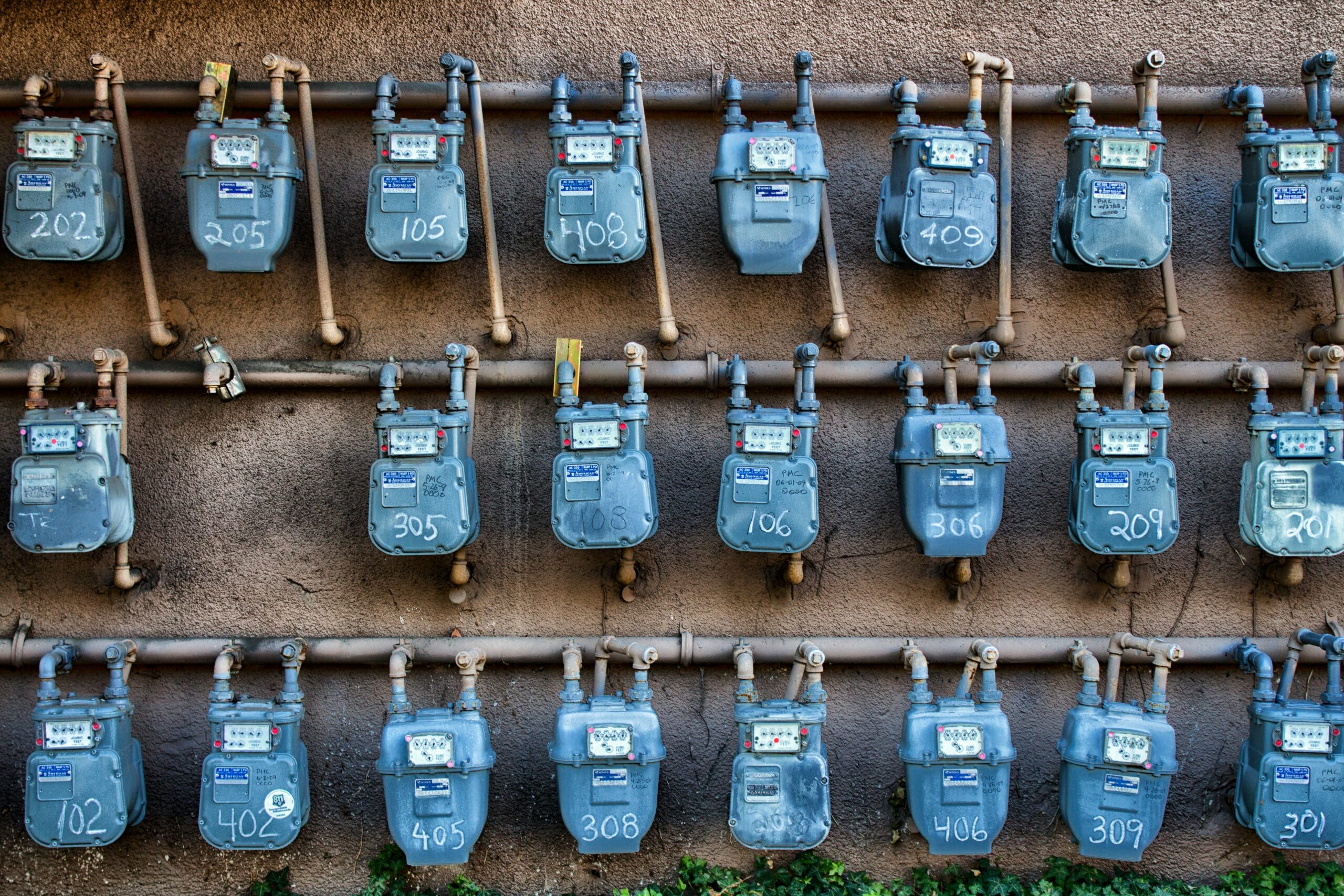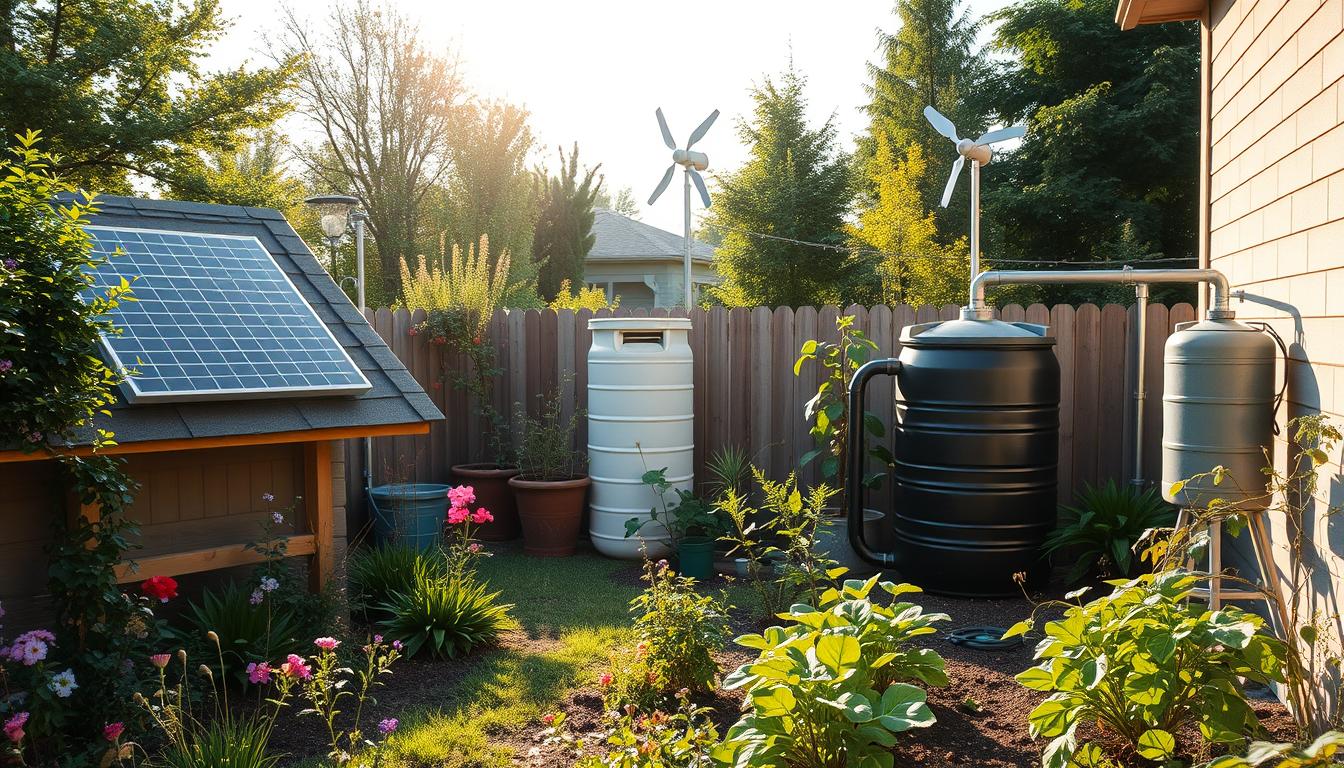I remember when my electricity bill was draining my wallet. That’s when I found out about renewable energy systems. It made sustainable living seem possible.
Renewable energy is more than just a trend. It’s a real solution for those wanting clean energy at home. Small solar systems can turn your roof into a clean power source. Wind and hybrid systems offer flexible ways to power your home.
My research showed that renewable energy systems are good for the planet and your wallet. They’re getting cheaper and easier to get. No matter where you live, there’s a renewable energy solution for you.
Key Takeaways
- Renewable energy systems offer a sustainable alternative to traditional electricity sources
- Multiple technology options exist for home power generation
- Initial investments can lead to significant long-term energy savings
- Clean energy reduces carbon footprint and environmental impact
- Grid-connected systems can potentially generate income through energy credits
Understanding Home Renewable Energy Basics
Renewable energy is changing how we power our homes. It now makes up 14% of the world’s energy. Homeowners are looking into sustainable energy to cut down on bills and help the planet.
Renewable energy systems are opening up new ways to generate power at home. It’s important to know the different technologies and how they fit into your home’s energy plan.
Types of Residential Renewable Energy
There are many renewable energy options for homeowners:
- Solar power systems
- Wind energy turbines
- Geothermal heat pumps
- Solar water heating
Benefits of Home Renewable Systems
Using renewable energy at home has many benefits:
- Lower electricity bills
- A smaller carbon footprint
- More energy independence
- Possible tax credits
Initial Considerations for Installation
Before getting into renewable energy, think about these key points:
| Consideration | Key Factors |
|---|---|
| Energy Efficiency | Improve insulation, seal air leaks, upgrade appliances |
| Resource Availability | Evaluate local solar, wind, and geothermal options |
| Economic Feasibility | Look at costs, savings, and tax incentives |
“Renewable energy is not just about power generation, it’s about creating a sustainable future for our homes and communities.”
By looking at your home’s needs and local energy options, you can make a smart choice. This choice supports both the environment and your energy use.
Assessing Your Home’s Energy Needs
Understanding your home’s energy use is key to a good renewable energy system. I’ll guide you through a detailed energy assessment. This will help you decide on your home’s electricity needs.
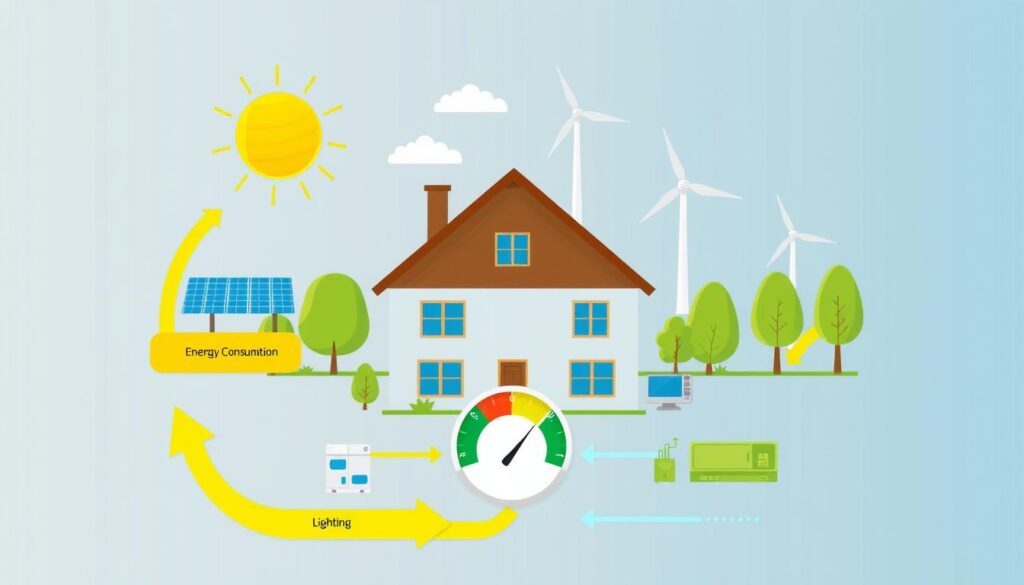
To begin, gather your electricity bills from the last year. This will show your energy use over time. Look at when you use the most energy and how it changes with the seasons.
- Calculate your average daily energy consumption
- Identify high-energy-consuming appliances
- Analyze seasonal energy use variations
- Consider future changes in household energy needs
Energy assessment is more than just looking at bills. You’ll need to list all your electrical devices and how often you use them. Multiply each appliance’s wattage by its daily hours to find your total electricity use.
“Knowing your energy consumption is the foundation of an effective renewable energy strategy.” – Clean Energy Expert
Before getting a renewable energy system, make your home more energy-efficient. Simple changes like using LED lights, better insulation, and energy-saving appliances can cut your energy use a lot.
| Appliance | Average Daily Watts | Hours Used | Daily Consumption |
|---|---|---|---|
| Refrigerator | 150 | 24 | 3,600 watts |
| LED Lights | 10 | 5 | 50 watts |
| Computer | 250 | 4 | 1,000 watts |
Professional energy consultants can give you a detailed analysis for your home. They aim to create a renewable energy system that fits your home’s unique needs perfectly.
Solar Power Solutions for Residential Use
Looking into solar energy can change how homes get electricity and use energy. Photovoltaic systems have made it possible for homes to use the sun’s power instead of traditional electricity.

For over a decade, many homes in the U.S. have added solar panels. The National Renewable Energy Laboratory says most homes need between 3-11 kilowatts of solar power.
Rooftop Solar Panel Installation
Putting up solar shingles and photovoltaic systems can cut down on electricity bills a lot. When thinking about rooftop solar, consider:
- How big the system needs to be
- The direction and sunlight on your roof
- The weather in your area
- How much you can spend and tax breaks
“An average home in Austin, Texas, can meet all its energy needs with a 7.15-kilowatt solar energy system.”
Solar Water Heating Systems
Solar water heating is a smart way to use less energy. It can give about half of a family’s hot water, saving money over time.
| System Type | Annual Energy Savings | Average Cost |
|---|---|---|
| Flat-Plate Collector | 40-50% | $3,000-$4,000 |
| Evacuated Tube Collectors | 50-60% | $4,500-$6,000 |
Solar Air Conditioning Options
New solar air conditioning tech can really lower cooling costs. These systems use the sun’s power to cool, cutting electricity bills by up to 50%.
The Solar Investment Tax Credit gives a 26% tax break for buying solar systems. This makes solar energy more affordable for homeowners who want green power.
Wind Energy for Home Power Generation
Looking into wind power for your home is a great step towards sustainable energy. Small wind electric systems can cut your electricity bills by 50% to 90%. They are perfect for homeowners looking for green energy options.

Wind turbines turn wind into electricity, making them a cool way to power your home. They come in sizes from 400 watts to 20 kilowatts, based on your energy needs. The performance of wind turbines depends on a few important things:
- Property size (minimum one acre recommended)
- Average annual wind speeds (at least 10 miles per hour)
- Tower height (60 to 140 feet)
- Rotor diameter
When thinking about wind power for your home, knowing the technical details is key. Most home wind turbines are horizontal-axis machines with two or three blades. Wind speeds increase with height, so a taller tower can boost your turbine’s power.
“A well-installed wind electric system can last up to 20 years, providing consistent renewable energy for your household.” – Renewable Energy Expert
Installing a small wind electric system can cost between $3,000 and $50,000. But, many governments and local utilities offer help to lower these costs. A 5 kW turbine in a place with moderate winds can make about 13,140 kWh a year. This can greatly cut down your need for grid electricity.
Grid-connected wind turbines offer more benefits. You can sell extra energy to the utility or store it for later. This not only saves money but also helps the environment. Wind energy helped avoid 198 million metric tons of CO2 emissions in 2020 in the United States.
Geothermal Heat Pump Systems
Geothermal energy is a leading choice for homes wanting to save energy and be kind to the planet. Ground source heat pumps use the Earth’s steady underground temperatures. This creates a system that cuts down on energy use a lot.

Geothermal heat pumps work on a simple yet groundbreaking idea. They use the Earth’s stable temperatures 30 feet down. This lets them efficiently move heat for both heating and cooling homes.
How Geothermal Systems Work
Ground source heat pumps use a special fluid in underground pipes. This fluid takes in or gives out heat based on the season. This makes them very energy-efficient. Unlike regular HVAC systems, they work well no matter the outside temperature.
- Underground temperatures stay between 50°F to 59°F
- Systems can be up to 500 percent efficient
- They cut carbon emissions by about 85 percent
Installation Requirements and Costs
Getting a geothermal system installed costs more than traditional heating at first. But, federal incentives can help a lot. The Inflation Reduction Act now offers tax credits that can cut costs by up to 50 percent.
| System Type | Installation Depth | Estimated Cost |
|---|---|---|
| Horizontal Closed-Loop | 6-5 feet | $10,000-$25,000 |
| Vertical Closed-Loop | 100-400 feet | $20,000-$35,000 |
Long-term Benefits and Savings
Getting a ground source heat pump system is a smart long-term choice. These systems can last up to 24 years indoors and over 50 years for the underground parts. They can save you money on energy bills in just 5-10 years.
“Geothermal heat pumps represent the future of sustainable home energy solutions.” – U.S. Department of Energy
Choosing geothermal energy means quieter operation, lower bills, and helping the environment. It’s a win-win for homeowners and the planet.
Renewable Energy Systems for Off-Grid Living
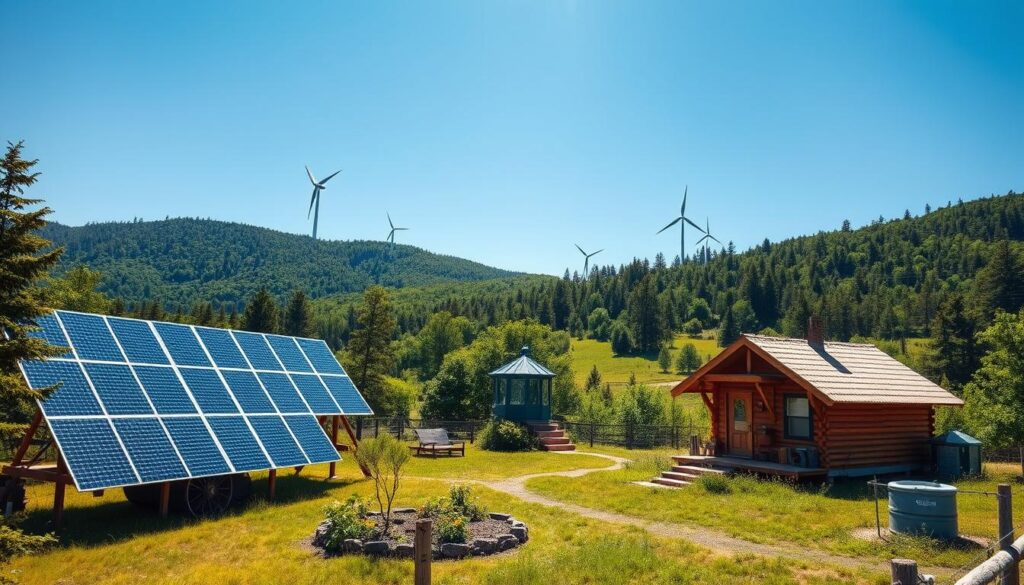
Off-grid systems are the key to energy freedom. They let homeowners create their own power without relying on the grid. This makes living off the grid sustainable and self-sufficient.
To plan an off-grid energy system, you need to know about different renewable energy options. It’s important to use a mix of power sources to keep the electricity flowing.
“Energy independence isn’t just about power generation – it’s about creating a resilient and sustainable living environment.”
- Solar photovoltaic systems
- Wind turbine generators
- Hybrid renewable energy configurations
- Battery storage solutions
Off-grid systems have a few key parts:
| Component | Function | Typical Lifespan |
|---|---|---|
| Solar Panels | Primary Energy Generation | 25-30 years |
| Battery Bank | Energy Storage | 5-15 years |
| Charge Controller | Power Regulation | 10-15 years |
| Inverter | Convert DC to AC Power | 10-15 years |
Setting up off-grid systems needs careful thought about your energy use. Knowing how much energy you use is key to a good renewable energy plan. Your location, the local resources, and your energy needs will shape your system.
Starting off-grid can cost a lot at first. But, the long-term savings and the good it does for the planet make it worth it. It’s a smart choice for those wanting to live sustainably.
Energy Storage Solutions and Battery Systems
Renewable energy is getting more popular, and energy storage is key. The global market for battery energy storage systems (BESS) has grown fast. In 2022, investments hit over $5 billion, and it’s expected to reach $150 billion by 2030.
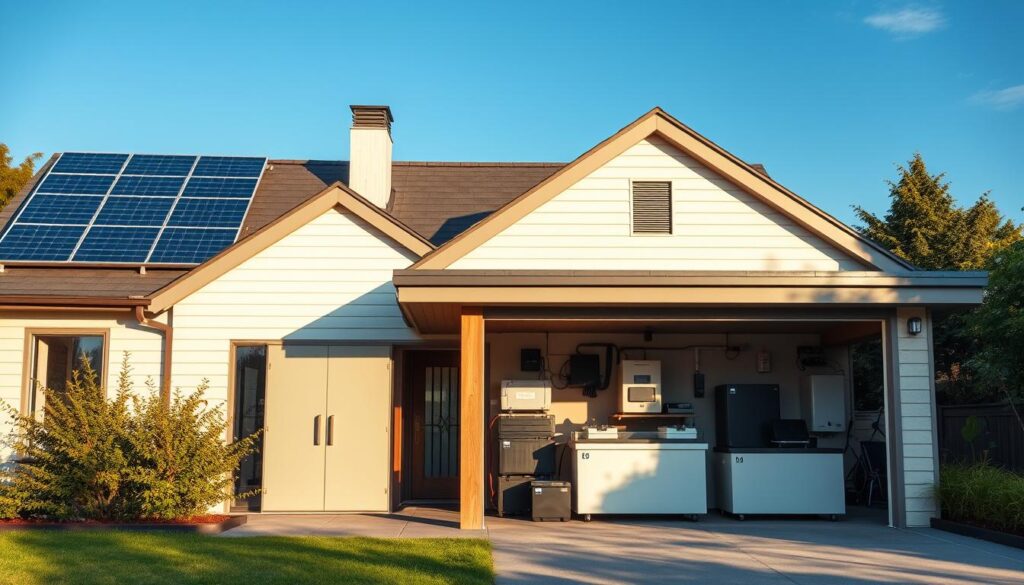
Modern battery systems give homeowners more control over their electricity use. They help make the most of renewable energy by storing extra power for later.
Tesla Powerwall and Comparable Technologies
The Tesla Powerwall is a big step forward in home energy storage. It has:
- Seamless integration with solar panels
- Backup power during grid outages
- Smart energy management
- Potential for big savings on electricity bills
“Early adopters have experienced substantial benefits from advanced battery storage technologies.” – Renewable Energy Expert
Grid Connection vs. Battery Storage
Homeowners have many ways to manage their energy. Battery storage systems offer special benefits:
- More energy independence
- Lower electricity costs
- Better resilience during power cuts
Lithium-ion batteries lead the energy storage field. But, new tech like Compressed Air Energy Storage (CAES) and Flow Batteries are also promising.
| Battery Type | Residential Use |
|---|---|
| Lithium-ion | High |
| Flow Batteries | Emerging |
| Compressed Air | Developing |
Investing in energy storage can change how we use and manage electricity. It brings both environmental and economic gains.
Cost Analysis and Financial Incentives
Investing in renewable energy can be a wise choice. Knowing about renewable energy incentives helps a lot. The support for clean energy has grown a lot in recent years. This makes it easier for homes to go green.

The Inflation Reduction Act of 2022 has changed the game for renewable energy tax credits. It offers big financial perks for using clean energy at home.
Key Financial Incentives
- Federal Investment Tax Credit (ITC) for solar systems
- Production tax credits for wind energy
- State-level energy rebates
- Property tax exemptions
- Local utility incentive programs
Cost Breakdown of Renewable Energy Systems
| Energy System | Average Installation Cost | Tax Credit Percentage |
|---|---|---|
| Solar PV System | $15,000 – $25,000 | 30% |
| Wind Energy System | $50,000 – $80,000 | 30% |
| Geothermal Heat Pump | $10,000 – $25,000 | 30% |
“The right financial incentives can reduce your renewable energy system costs by up to 50%.” – Renewable Energy Expert
I suggest looking at the Database of State Incentives for Renewables & Efficiency (DSIRE). It shows the specific rebates and tax credits in your area. Each state has its own way of supporting renewable energy.
Additional Financial Strategies
- Check local utility net metering policies
- Investigate Rural Energy for America Program (REAP) grants
- Consult with tax professionals about renewable energy credits
Pro tip: Many renewable energy incentives have specific timelines, so act quickly to maximize your financial benefits.
Legal Requirements and Building Codes
Renewable energy systems come with legal hurdles. States and local areas have their own rules. These rules affect your home energy project.

It’s key to know these rules for a successful install. Following them means safety, efficiency, and legal safety for your investment.
Permits and Zoning Regulations
Local authorities need specific permits for renewable energy setups. These rules change based on where you are and the system you want.
- Check local building codes before starting your project
- Obtain necessary construction and electrical permits
- Verify zoning restrictions for renewable energy systems
- Consult with local building inspectors
Grid Connection Requirements
Connecting to the grid has its own rules. Utility companies have strict guidelines for this.
| Requirement Category | Key Considerations |
|---|---|
| Technical Standards | Meet National Electrical Code specifications |
| Safety Protocols | Install certified equipment and protective systems |
| Utility Approval | Submit detailed system design and interconnection application |
HOA and Community Guidelines
Homeowners associations have rules for renewable energy. Some communities support green energy, while others have strict rules.
Approximately 40 national governments worldwide have established building energy codes, highlighting the growing importance of sustainable energy regulations.
I suggest looking into your local renewable energy laws. Talk to professional installers who know the local codes. Good communication with local authorities can make your project smoother.
Maintenance and Long-term Considerations

Keeping your renewable energy system in top shape is key to its long-term success. It’s all about proactive maintenance to keep your home running smoothly. This approach helps you get the most out of your investment.
“Predictive maintenance is the key to extending the lifespan of renewable energy systems and optimizing their performance.”
The global predictive maintenance market for energy is expected to soar. It’s projected to hit $5.62 billion by 2029. This shows how vital it is to have a solid plan for keeping your energy system running well for years.
Key Maintenance Considerations
- Conduct annual inspections of mechanical and electrical connections
- Clean solar panels to maintain optimal energy production
- Check battery water levels monthly
- Verify electrical connection tightness
- Monitor system performance through remote diagnostics
Different renewable energy systems need their own maintenance plans:
| System Type | Maintenance Frequency | Key Inspection Points |
|---|---|---|
| Solar Panels | Annually | Panel integrity, electrical connections |
| Wind Turbines | Twice Yearly | Moving parts, electrical systems |
| Geothermal Systems | Every 2-3 Years | Pump efficiency, ground loop integrity |
New tech like AI and thermal imaging is changing how we maintain systems. These tools help us watch over our systems more closely. They also predict when maintenance is needed, reducing downtime and boosting energy output.
By regularly maintaining your system and keeping up with new tech, you can keep it efficient and reliable. This way, your renewable energy system will serve you well for many years.
| Ready to Take Control of Your Energy Future? As you’ve learned, renewable energy systems are a fantastic way to lower your carbon footprint and reduce your energy bills. But what if you could take things a step further, with a groundbreaking invention that could change the way we think about energy forever? Introducing Edison’s ‘Lost Invention’—a revolutionary technology that generates unlimited energy on demand. Imagine never having to worry about high electricity costs or power shortages again. This innovation could be the missing link in creating a truly sustainable future for your home and beyond. 👉 Discover more about Edison’s Lost Invention and how it could help you achieve energy independence today! Click here to learn more. Take the next step toward a limitless energy future! |
Conclusion
My exploration of sustainable home solutions has shown how renewable energy can change our lives. Right now, renewables make up only 11.4% of the world’s energy. But, there’s a lot of room for growth in clean energy for homes.
Statistics show that low-carbon energy has grown from 6% to nearly 18% in 60 years. This is good news for homeowners who want to be energy independent.
Renewable energy does more than help the planet. It’s also a smart choice for saving money on energy in the long run. There are challenges, like the cost of starting up and connecting to the grid. But, new tech is making these problems smaller.
Now, we have better storage and smart grids for home use. These make renewable energy more practical and reliable for our homes.
Choosing renewable energy at home is more than just a personal choice. It’s part of a big push for a greener world. As solar, wind, and geothermal tech gets better, we can all help change our energy future.
By picking renewable energy, we’re not just cutting down on carbon. We’re also joining a global effort for a cleaner, greener future.
The future of renewable energy looks bright. We need to see renewable energy production grow six times by 2050. Our choices about home energy are more important than ever.
I’m hopeful about the clean energy future we can build together. It starts with small steps, like adding solar panels or wind turbines to our homes.
FAQ
What are the main types of residential renewable energy systems?
I can explain the main types of renewable energy for homes. You have solar photovoltaic systems, small wind electric systems, geothermal heat pumps, and microhydropower systems. Each has its own benefits and fits best based on your location, energy needs, and local resources.
How much does a typical residential renewable energy system cost?
Prices vary by technology. Solar PV systems cost about per watt, so a 7 kW system is around ,000. Small wind systems cost between ,000 and ,000, averaging per 120 kilowatts. Even though they’re expensive upfront, they save money in the long run and may have tax benefits.
How do I determine if my property is suitable for renewable energy?
First, assess your electricity use and local wind speeds (at least 10 miles per hour for wind turbines). Also, check your property’s solar exposure and geological features. A renewable energy expert can give a detailed evaluation for your site.
Can renewable energy systems completely power my home?
Yes, you can power your home fully with renewable systems. But it depends on several factors. Grid-connected systems can use both renewable and grid power. Off-grid systems need careful planning for consistent energy supply through batteries and multiple sources.
What maintenance do renewable energy systems require?
Maintenance needs vary by system. Solar panels need occasional cleaning and checks. Wind turbines require more frequent inspections. Geothermal heat pumps are durable but need professional maintenance. Regular checks and repairs keep systems running efficiently.
Are there financial incentives for installing renewable energy systems?
Yes, there are many incentives to help with costs. The Investment Tax Credit offers big credits for solar installations. States also have rebates and net metering. The Database of State Incentives for Renewables & Efficiency is a great resource for local incentives.
How do energy storage solutions work with renewable systems?
Energy storage systems like the Tesla Powerwall store excess renewable energy. They save energy for later use, providing independence and smoothing out energy generation fluctuations.
What are the environmental benefits of residential renewable energy?
Renewable energy systems greatly reduce carbon footprints. They produce clean electricity without emissions, reducing fossil fuel use. Every kilowatt-hour from renewables fights climate change.
Source Links
- Planning for Home Renewable Energy Systems
- Residential Renewable Energy
- Introduction to Renewable Energy
- Understanding the Basics of Renewable Energy
- Renewable Energy
- ASSESSING YOUR HOME ENERGY NEEDS…
- How to Choose a Renewable Energy Source for Your Home
- All About Home Solar Alternative Energy
- Homeowner’s Guide to Going Solar
- Residential Solar Wind Power Systems | Inspire Clean Energy
- Residential Solar, Clean Energy Storage & EV Charging
- Small Wind Electric Systems
- Installing and Maintaining a Small Wind Electric System
- Harness Renewable Energy with a Home Wind Power Generator
- Geothermal Heat Pumps
- Geothermal Heat Pumps
- Clean Energy 101: Geothermal Heat Pumps – RMI
- Off-Grid Power: Sustainable Solutions for Independence – Bloom Energy
- A Guide to Sustainable Energy Sources – Ledger
- 7 Types of Off-Grid Power Systems and the Safety Components You’ll Need for Them
- Enabling renewable energy with battery energy storage systems
- Energy Storage Solutions – A new energy storage program for Connecticut Eversource and UI customers
- A Comprehensive Look at Renewable Energy Battery Solutions
- CREST: Cost of Renewable Energy Spreadsheet Tool
- Financial Incentives to Enable Clean Energy Deployment: Policy Overview and Good Practices
- WINDExchange: Wind Energy Financial Incentives
- Federal Building Energy Efficiency Rules and Requirements
- Building Energy Codes: Policy Overview and Good Practices
- Predictive Maintenance for the Renewable Energy Sector
- Renewable-Energy Systems: Important Maintenance Practices
- Predictive Maintenance in Renewable Energy Installations – KnowHow
- Can renewable energy replace fossil fuels in the future?
- Summary and Conclusion
- Renewable Energy Systems: Transforming Electric Grids Worldwide
Affiliate Disclosure: This article contains affiliate links, meaning I may earn a commission if you click through and make a purchase, at no extra cost to you.


